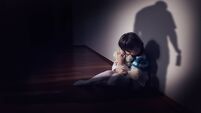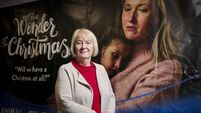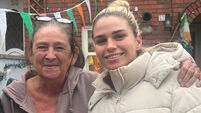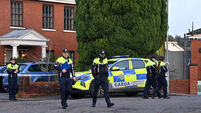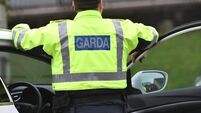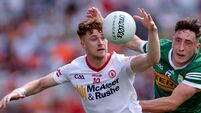VIDEO: Quest to find the missing names of people in iconic O'Donovan Rossa funeral photograph

A project to put names to the faces in the crowd has positively identified dozens. But Glasnevin Cemetery – where the historic photograph was taken a century ago today – hopes more relatives will come forward to help fill the remaining gaps.
Many faces in the crowd are instantly recognisable, besides Pearse who holds his cap in his hand, to the right of future Sinn Féin vice-president Fr Michael O’Flanagan. Looking on a little further to the right is veteran Fenian Tom Clarke, who many believe was the real brain behind the Easter Rising that would shake the capital eight months later.
But it was the speech of Pearse - promising ‘Ireland unfree shall never be at peace’ - delivered moments after the scene was captured for posterity that retrospectively made the funeral so infamous and gave resolve to the Irish Republican Brotherhood plotters of the imminent rebellion.Also among the more identifiable subjects are Pearse and Clarke’s fellow-signatory to the Proclamation of the Republic, Thomas MacDonagh, and another executed for his part in the Rising, Major John MacBride.
Other leading figures in the revolutionary years that would follow include Sinn Féin founder Arthur Griffith, Seán McGarry who was key to re-organising the Irish Republican Brotherhood (IRB) and Irish Volunteers after 1916, future President of Ireland Seán T O’Kelly, and future IRA publicist, Kerry TD and Michael Collins biographer Piaras Béaslaí.
Some of the figures have been identified over recent months as a result of Glasnevin Museum’s appeal for people to nominate their relatives or others they recognised in the iconic photograph.
While most focus was on the prominent figures, two women near the back of the crowd were recognised by a Dublin man Donal Gilligan as his late mother Honora Traynor – who had her own copy of the photo – and her friend Annie Coyne.
It is hoped that the recent focus on the famous scene might prompt others to get in touch and offer names of grandparents, or other relatives who were there.
“We wanted to try and identify as many people as possible around Pearse, who were there to witness this historic moment,” said Conor Dodd, historian at Glasnevin Cemetery.
Besides those featuring prominently in the foreground, the image features almost 60 members of the St James’s Band whose names are also known. But one bandsman is not in the shot as he is believed to have been responsible for surreptitiously taking the photograph.
Although the photo and film footage of the funeral would later be used for propaganda purposes, the IRB organisers of the event were said to be anxious not to have their images taken. They feared it could be invaluable to the authorities, looking to identify suspected militants.
However, many of their number were the subject of ongoing intelligence on their movements for as long as a decade beforehand, as evidenced in Royal Irish Constabulary and Dublin Metropolitan Police files that have since become available to researchers.
The significance of public interest in Jeremiah O’Donovan Rossa’s funeral on Sunday, August 1, 1915, is hard to put into context today.

A cortège of 20,000 people followed his coffin in its horse-drawn hearse through the streets of Dublin, and hundreds of thousands more lined the streets along the route from City Hall to Glasnevin Cemetery.
The tone and content of Padraig Pearse’s now-infamous oration at the dead Fenian’s graveside is enshrined in the history of preparations for the 1916 Rising. “The fools. The fools. The fools,” he said. “They have left us our Fenian dead. And while Ireland holds these graves, Ireland unfree shall never be at peace.”
But it was equally the open defiance of the Irish Volunteers and Irish Citizen Army, who marched through the capital’s streets in their thousands in that cortege, that emboldened the Irish Republican Brotherhood’s military council to forge ahead with those rebellion plans.
Most of the key planners and participants were centrally involved in organising the funeral of O’Donovan Rossa, who died at the end of June 1915 in exile in New York. Names like Pearse, James Connolly, Tom Clarke, Eamonn Ceannt, Joseph Plunkett, Seán McDermott, Con Colbert, Ned Daly, and others appear alongside future major figures in the Irish political and military revolution like Eamon de Valera, Cathal Brugha, Diarmuid Lynch, Arthur Griffith and Countess Markievicz on the funeral committee listed in the souvenir brochure produced for the occasion.
Special trains were laid on from around the country. The same holiday weekend saw Kerry’s junior and senior football sides pull out of their scheduled Munster championship semi-final ties with Cork and Tipperary at Cork Athletic Grounds. The reason given was the clash of the fixtures with O’Donovan Rossa’s burial, and the Saturday edition of the Cork Examiner recorded efforts being made to charter a special train from Tralee to connect with the Cork service at Mallow for those wishing to attend.
The Cork service organised by the O’Donovan Rossa Funeral Committee left at 8am on Sunday, preceded by a Mass in the nearby St Patrick’s Church. When the special train arrived into Dublin’s Kingsbridge (now Heuston) station, young Irish Volunteer Liam de Róiste who had travelled up the night before was handed his Mauser rifle by one of his fellow Cork Volunteers.

The ranks of Volunteers arriving by train from Kilkenny, Waterford, Limerick and Cork marched to James’s St, and awaited orders to advance in the cortege that left at 2pm from City Hall, where O’Donovan Rossa had been lying in state, his face uncovered under a glass shade.
The assembled Volunteers later got the order to march from James’s St “to the sound of muffled drums and the sad music of the Dead March, with slow steps and arms reversed.”
While the rifles and other weapons may not have had any ammunition in the breach, historian Gabriel Doherty says the 5,000 men who marched with them sent a clear message to the authorities and the government in London.
“The fact that thousands of National Volunteers, Irish Volunteers and Irish Citizen Army members paraded through Dublin in open contempt of the Dublin Metropolitan Police, and in support of the most hardline Fenian of them all was something very striking,” he says.
The DMP’s hands-off approach, Mr Doherty says, was probably because it was just days since the first anniversary of the Bachelor’s Walk massacre. Four civilians died when soldiers intervened after the retrieval of the guns brought into Howth by the Irish Volunteers, and the government did not want to risk a repeat event.
But that inaction fuelled the IRB Military Council to advance their still-secret Rising plans.
Ever since O’Donovan Rossa’s death in New York on June 29, newspapers were filled with reports of votes of sympathy by poor law unions, boards of guardians, rural and urban, county and borough councils, and wreaths were piled high afterwards around the Glasnevin graveside.
The government might almost have taken some consolation if those sentiments turned sour, into public disturbances or violence that might sully the separatist’s growing public popularity. But, Mr Doherty says, perfect discipline was displayed on the day: “There was frightening precision in its execution, which gives an idea of how successful the Rising might have been.”
But circumstances meant things were much different, as the German guns being imported for the rebellion failed to land in Co Kerry on Easter weekend of 1916, prompting Irish Volunteers chief Eoin McNeill to cancel the national mobilisation that was supposed to kick-start the Rising that he had only just found out about himself.
There are over 1,200 search results found for O’Donovan Rossa in the ‘Irish Examiner’ archive. Whether you are a researcher, historian or you want to explore your history visit
Among those attending this morning’s commemorative ceremony in Glasnevin are Irish and US descendants of Jeremiah O’Donovan Rossa.

They are among the 500 dignitaries and invited guests at the first State ceremony in the 1916 Centenary programme. Another 1,500 spaces have been set aside for members of the public who successfully applied for tickets, which were in equal demand but scarce supply a century ago.
As well as President Michael D Higgins and Taoiseach Enda Kenny, Northern Ireland Deputy First Minister Martin McGuinness, Arts and Heritage Minister Heather Humphreys and diplomatic representatives from the UK, Poland, and the Vatican will attend.
“One thing we have found here over the last five years is the common and shared commemoration of everything, from World War I events to O’Donovan Rossa’s funeral,” said Glasnevin Trust chief executive George McCullough.
The proceedings are televised live on RTÉ One from 10.35am but around 5,000 people can be accommodated to see them relayed to live screens outside the cemetery. No tickets are required but parking restrictions are in place.
Before the speech of Pádraig Pearse is delivered, President Higgins will lay a wreath on O’Donovan Rossa’s grave, followed by a minute’s silence and a piper’s lament.
The event follows the timeline of proceedings as they happened at the funeral itself on Sunday, August 1, 1915, the souvenir brochure for which has been reproduced for the occasion.
The historic funeral cortege through Dublin City centre to Glasnevin Cemetery will be recreated later today in a separate event organised by Sinn Féin.
After a recreation of the dead patriot lying in state at Dublin City Hall, a horse-drawn hearse will leave at 2pm and make its way along Westmoreland St, O’Connell St, Parnell Square and on to the cemetery by 3pm.
The public is being encouraged to line the route in period dress to replicate the scene of 100 years ago.
Two bronze plaques are being unveiled at O’Donovan Rossa Bridge in Dublin by the National Graves Association at 3pm. The organisation will hold a wreath-laying ceremony and re-enactment of Pearse’s oration at the cemetery at 4.30pm, and a new print of the funeral scene will be launched by artist Robert Ballagh at Glasnevin museum an hour later.
The museum opens an exhibition on the O’Donovan Rossa funeral tomorrow, and it will run until next March. It includes items unique to the cemetery, and a large version of the coloured photograph of the historic graveside scene published on page 1 of today’s Irish Examiner.







